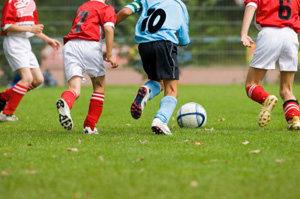
An injury at sport may be acute and require immediate attention. These types of injuries are discussed under
Fracture ,
Dislocation and
AC joint-Collarbone . Other sports injuries, discussed in this section, start more gradually and are characterised by pain in the shoulder during or after the sporting activity. Initially the pain lasts for a few hours after sport, but as the problem progresses the pain may be present all the time and aggravated by sport.
Internal glenoid impingement
This condition affects people who participate in sports requiring overhead throwing. It is characterised with pain on the top and back of the shoulder when throwing or smashing in racquet sports.
This is due to rubbing of the under surface of the rotator cuff tendons against the back of the shoulder socket (glenoid) in the throwing position. This may be related to slight anterior shoulder instability allowing the ball of the shoulder joint to move forward with throwing or tightening of the posterior capsule (lining of the shoulder joint).
Over 80% of the time, this condition improves with initially avoiding the activity causing the pain and physiotherapy to strengthen the shoulder blade and rotator cuff muscles as well as stretching the posterior capsule. This may take 3-6 months to achieve.
Occasionally, surgery may be required to correct the anterior instability and/or address a tear to the under surface of the rotator cuff tendons.
Anterior instability - Impingement
People under the age of 35 years rarely have impingement or rotator cuff problems. People of that age group suffering with pain similar to impingement pain (Impingement & Rotator cuff) , after overhead activity, tend to have anterior instability.
This is due to stretching of the anterior shoulder ligaments allowing the ball of the shoulder joint to move forwards with overhead activity. This forward movement pinches the rotator cuff tendons between the ball of the shoulder joint and the top shelf of shoulder blade bone (acromion) causing impingement.
Again, over 80% of the time, avoiding painful activity and physiotherapy will improve the pain within 3-6 months.
Occasionally, surgery to address the anterior instability is required. Surgery to address the impingement process is not required and may be harmful in this situation.
Superior Labrum Anterior & Posterior lesions (SLAP lesions)
The labrum is the structure that attaches the ligaments of the shoulder joint to the shoulder socket (glenoid). In its top part (superior), the labrum helps attach the tendon of the biceps muscle to the shoulder socket. This attachment of the tendon of the biceps muscle to the socket of the shoulder joint may become detached (SLAP lesion). This may happen as an injury during overhead sport, after a fall when you put your arm out to cushion the fall or as a driver holding to the steering wheel during a car crash.
This causes pain and occasionally clicking with sporting activity. It may also cause a feeling of instability if the labral detachment extends anteriorly or posteriorly.
This condition may be difficult to diagnose even after a magnetic resonance (MRI) scan. Treatment usually involves keyhole surgery to repair the torn attachment of the biceps tendon.
Posterior Instability
As mentioned in the section on instability & dislocation, a posterior dislocation of the shoulder joint is rare. If it happens, it requires the shoulder joint to be put back urgently. As this injury is rare, it is occasionally missed. A missed dislocation requires extensive open surgery to put the joint back in.
A more common problem is posterior subluxation (partial dislocation, that goes back in joint on its own) of the shoulder joint. This may happen after one injury in which the shoulder is pushed back forcibly, with the arms lifted in front of the body. It may also happen after repeated more minor but similar injuries.
This causes pain on the back of the shoulder joint when the arm is lifted in front of the body and people with this condition may be able to demonstrate the clicking of the shoulder in and out of joint.
Over 70% of the time, this can be treated by avoiding the activity that cause the pain or subluxation and physiotherapy to strengthen the posterior rotator cuff muscles and the posterior part of the deltoid muscle.
Occasionally, surgery to repair the detached posterior labrum or more commonly to tighten the stretched posterior capsule is required. This is normally a keyhole operation but may be an open operation if the amount of capsular stretching is great.
Back to top